2002 SUBARU FORESTER warning
[x] Cancel search: warningPage 308 of 466
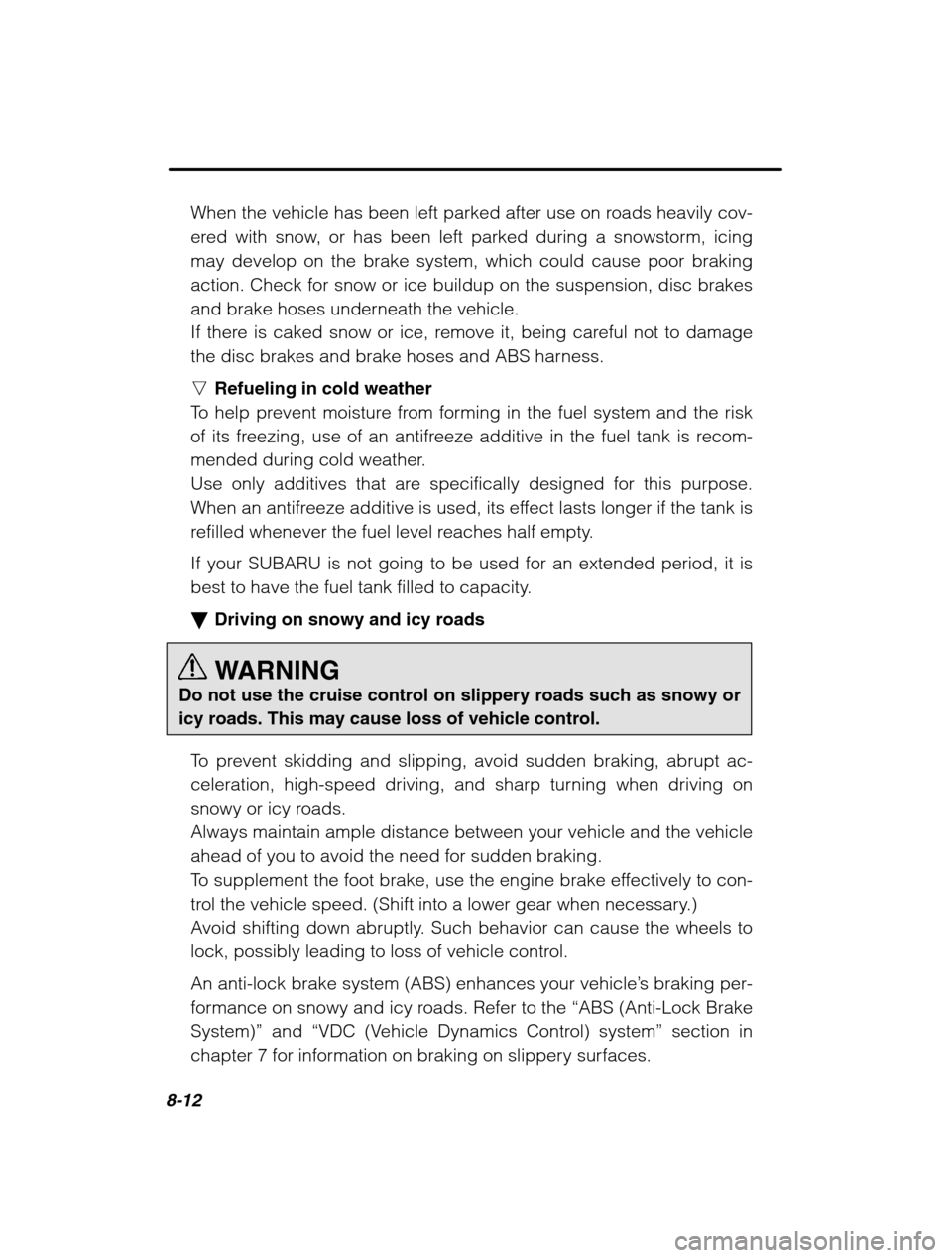
8-12
When the vehicle has been left parked after use on roads heavily cov-
ered with snow, or has been left parked during a snowstorm, icingmay develop on the brake system, which could cause poor braking
action. Check for snow or ice buildup on the suspension, disc brakes
and brake hoses underneath the vehicle.
If there is caked snow or ice, remove it, being careful not to damage
the disc brakes and brake hoses and ABS harness. nRefueling in cold weather
To help prevent moisture from forming in the fuel system and the risk
of its freezing, use of an antifreeze additive in the fuel tank is recom-
mended during cold weather.
Use only additives that are specifically designed for this purpose.
When an antifreeze additive is used, its effect lasts longer if the tank is
refilled whenever the fuel level reaches half empty. If your SUBARU is not going to be used for an extended period, it is
best to have the fuel tank filled to capacity. � Driving on snowy and icy roads
WARNING
Do not use the cruise control on slippery roads such as snowy or icy roads. This may cause loss of vehicle control.
To prevent skidding and slipping, avoid sudden braking, abrupt ac-
celeration, high-speed driving, and sharp turning when driving on
snowy or icy roads.Always maintain ample distance between your vehicle and the vehicleahead of you to avoid the need for sudden braking.
To supplement the foot brake, use the engine brake effectively to con-
trol the vehicle speed. (Shift into a lower gear when necessary.)
Avoid shifting down abruptly. Such behavior can cause the wheels to
lock, possibly leading to loss of vehicle control.
An anti-lock brake system (ABS) enhances your vehicle ’s braking per-
formance on snowy and icy roads. Refer to the “ABS (Anti-Lock Brake
System)” and “VDC (Vehicle Dynamics Control) system ” section in
chapter 7 for information on braking on slippery surfaces.
Page 309 of 466
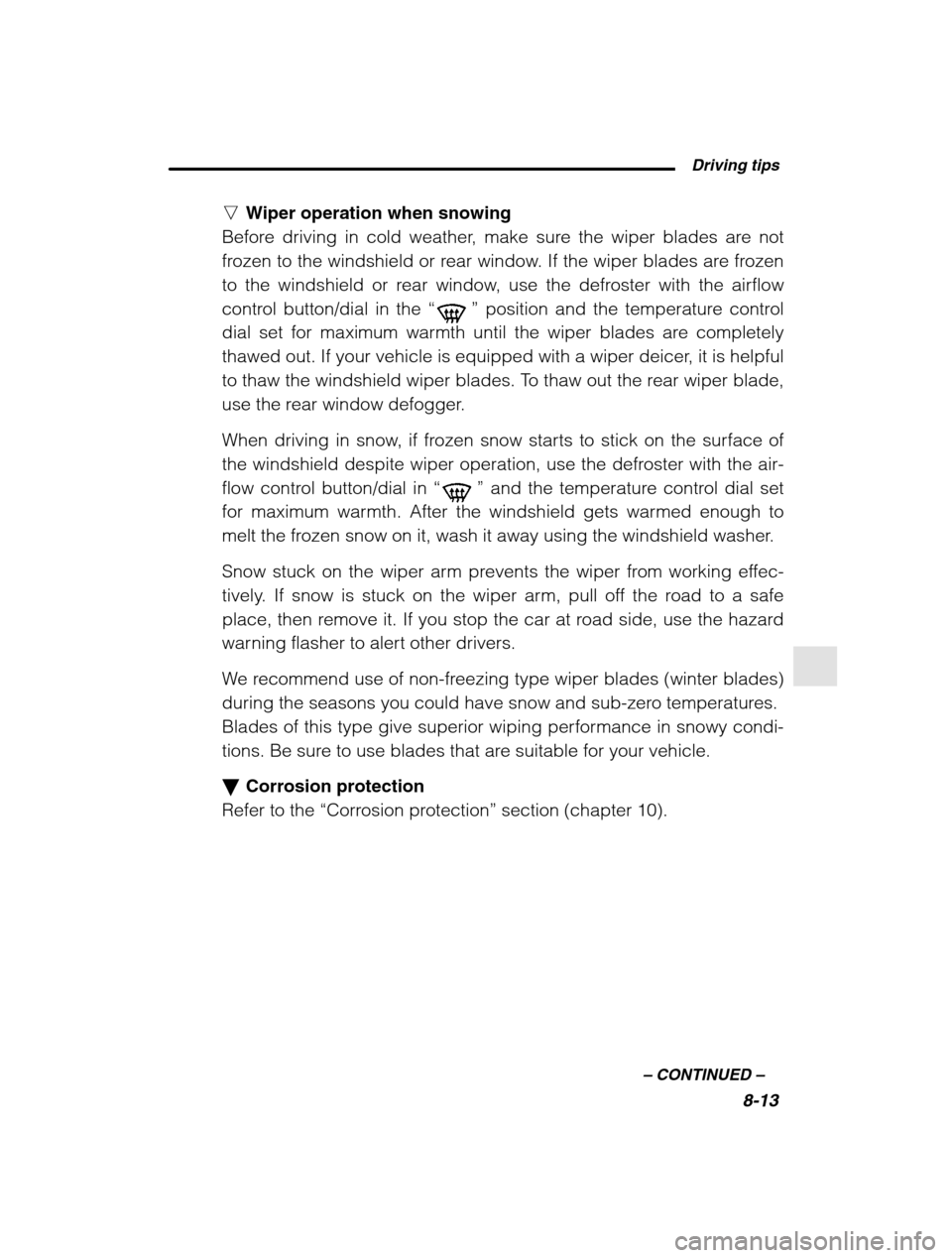
Driving tips8-13
–
CONTINUED –
nWiper operation when snowing
Before driving in cold weather, make sure the wiper blades are not
frozen to the windshield or rear window. If the wiper blades are frozen
to the windshield or rear window, use the defroster with the airflow
control button/dial in the “
” position and the temperature control
dial set for maximum warmth until the wiper blades are completely
thawed out. If your vehicle is equipped with a wiper deicer, it is helpful
to thaw the windshield wiper blades. To thaw out the rear wiper blade,
use the rear window defogger.
When driving in snow, if frozen snow starts to stick on the surface of
the windshield despite wiper operation, use the defroster with the air-
flow control button/dial in “
” and the temperature control dial set
for maximum warmth. After the windshield gets warmed enough to
melt the frozen snow on it, wash it away using the windshield washer.
Snow stuck on the wiper arm prevents the wiper from working effec-
tively. If snow is stuck on the wiper arm, pull off the road to a safe
place, then remove it. If you stop the car at road side, use the hazard
warning flasher to alert other drivers.
We recommend use of non-freezing type wiper blades (winter blades)
during the seasons you could have snow and sub-zero temperatures.
Blades of this type give superior wiping performance in snowy condi-
tions. Be sure to use blades that are suitable for your vehicle. � Corrosion protection
Refer to the “Corrosion protection ” section (chapter 10).
Page 310 of 466
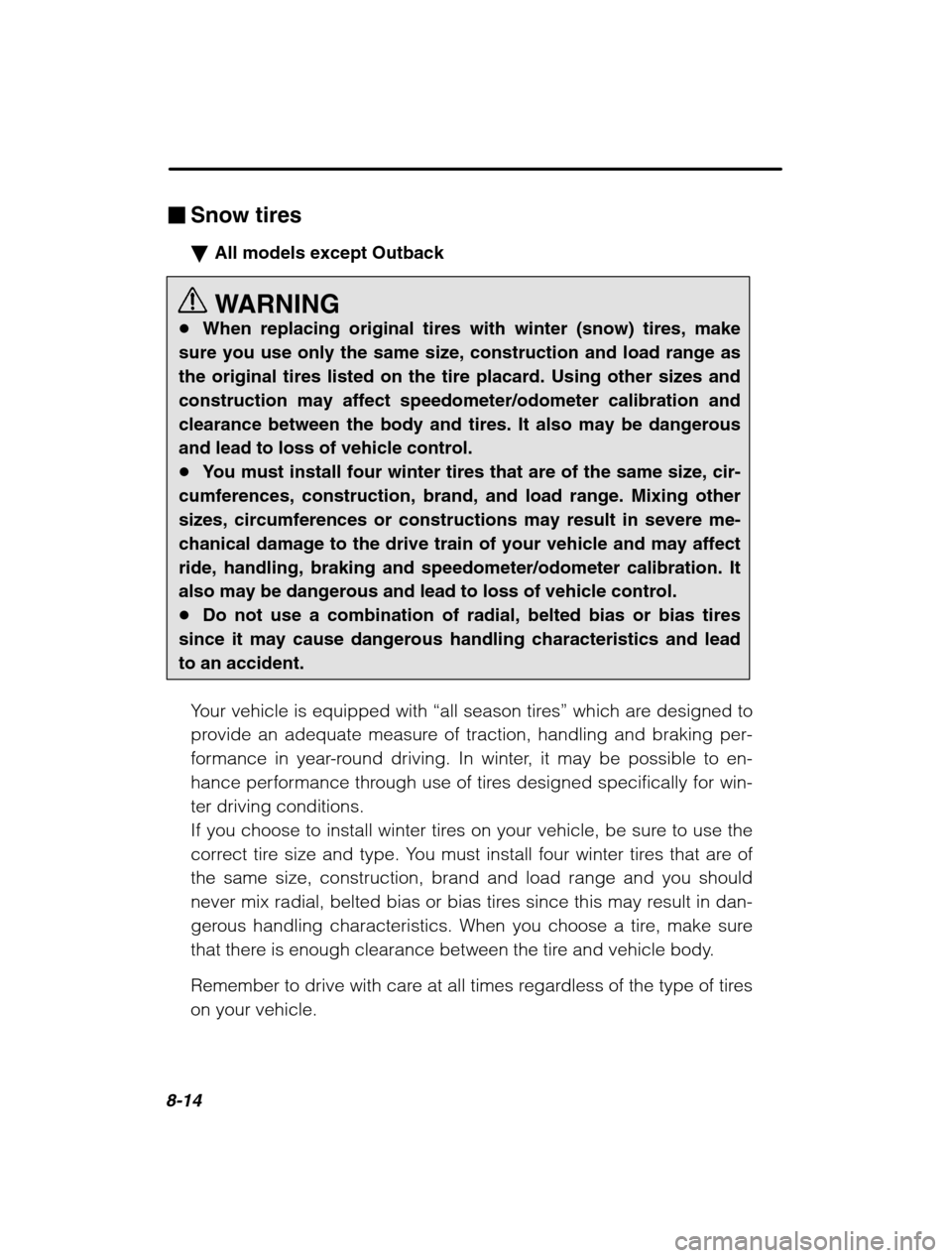
8-14
�Snow tires �All models except Outback
WARNING
� When replacing original tires with winter (snow) tires, make
sure you use only the same size, construction and load range as the original tires listed on the tire placard. Using other sizes andconstruction may affect speedometer/odometer calibration and
clearance between the body and tires. It also may be dangerousand lead to loss of vehicle control.� You must install four winter tires that are of the same size, cir-
cumferences, construction, brand, and load range. Mixing othersizes, circumferences or constructions may result in severe me-
chanical damage to the drive train of your vehicle and may affect
ride, handling, braking and speedometer/odometer calibration. Italso may be dangerous and lead to loss of vehicle control.� Do not use a combination of radial, belted bias or bias tires
since it may cause dangerous handling characteristics and leadto an accident.
Your vehicle is equipped with “all season tires ” which are designed to
provide an adequate measure of traction, handling and braking per-
formance in year-round driving. In winter, it may be possible to en-
hance performance through use of tires designed specifically for win-ter driving conditions.
If you choose to install winter tires on your vehicle, be sure to use the
correct tire size and type. You must install four winter tires that are ofthe same size, construction, brand and load range and you should
never mix radial, belted bias or bias tires since this may result in dan-
gerous handling characteristics. When you choose a tire, make sure
that there is enough clearance between the tire and vehicle body.
Remember to drive with care at all times regardless of the type of tires on your vehicle.
Page 311 of 466
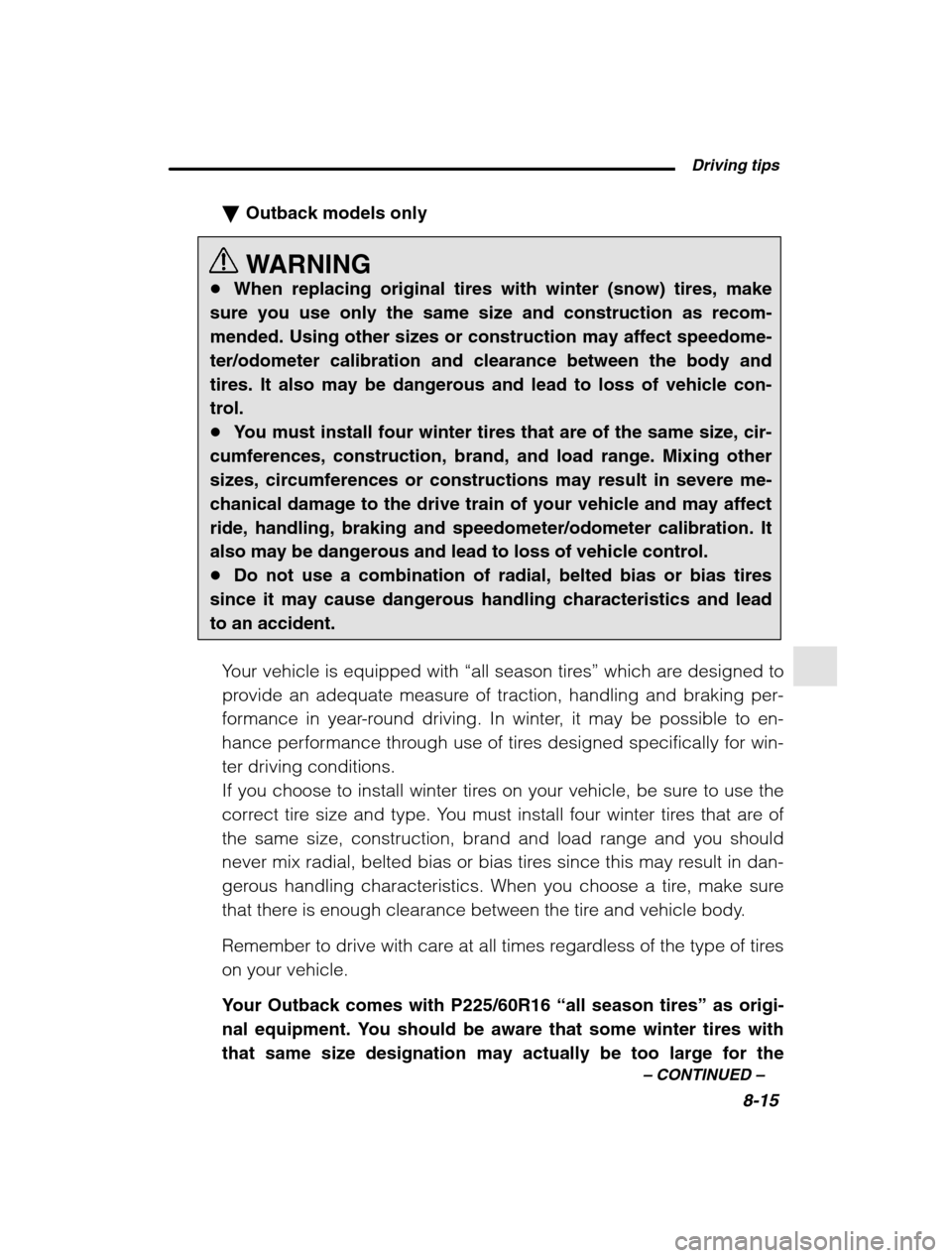
Driving tips8-15
–
CONTINUED –
�Outback models only
WARNING
� When replacing original tires with winter (snow) tires, make
sure you use only the same size and construction as recom- mended. Using other sizes or construction may affect speedome-ter/odometer calibration and clearance between the body and
tires. It also may be dangerous and lead to loss of vehicle con-trol.� You must install four winter tires that are of the same size, cir-
cumferences, construction, brand, and load range. Mixing othersizes, circumferences or constructions may result in severe me-
chanical damage to the drive train of your vehicle and may affect
ride, handling, braking and speedometer/odometer calibration. Italso may be dangerous and lead to loss of vehicle control.� Do not use a combination of radial, belted bias or bias tires
since it may cause dangerous handling characteristics and leadto an accident.
Your vehicle is equipped with “all season tires ” which are designed to
provide an adequate measure of traction, handling and braking per-
formance in year-round driving. In winter, it may be possible to en-
hance performance through use of tires designed specifically for win-ter driving conditions.
If you choose to install winter tires on your vehicle, be sure to use the
correct tire size and type. You must install four winter tires that are ofthe same size, construction, brand and load range and you should
never mix radial, belted bias or bias tires since this may result in dan-
gerous handling characteristics. When you choose a tire, make sure
that there is enough clearance between the tire and vehicle body.
Remember to drive with care at all times regardless of the type of tires on your vehicle.
Your Outback comes with P225/60R16 “all season tires ” as origi-
nal equipment. You should be aware that some winter tires with that same size designation may actually be too large for the
Page 313 of 466
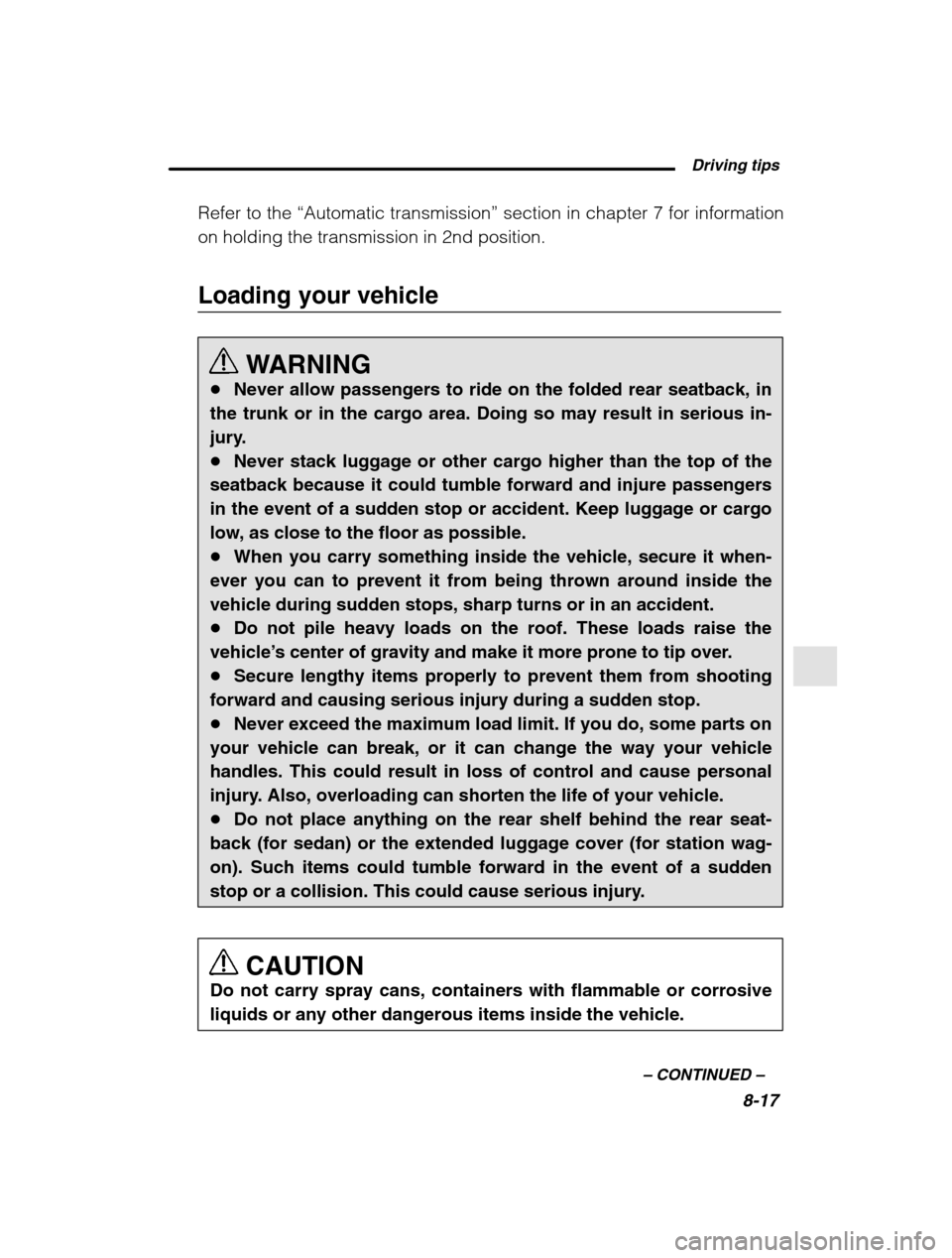
Driving tips8-17
–
CONTINUED –
Refer to the “Automatic transmission ” section in chapter 7 for information
on holding the transmission in 2nd position.
Loading your vehicle
WARNING
� Never allow passengers to ride on the folded rear seatback, in
the trunk or in the cargo area. Doing so may result in serious in-
jury.� Never stack luggage or other cargo higher than the top of the
seatback because it could tumble forward and injure passengersin the event of a sudden stop or accident. Keep luggage or cargo
low, as close to the floor as possible.� When you carry something inside the vehicle, secure it when-
ever you can to prevent it from being thrown around inside the
vehicle during sudden stops, sharp turns or in an accident.� Do not pile heavy loads on the roof. These loads raise the
vehicle’ s center of gravity and make it more prone to tip over.
� Secure lengthy items properly to prevent them from shooting
forward and causing serious injury during a sudden stop.� Never exceed the maximum load limit. If you do, some parts on
your vehicle can break, or it can change the way your vehicle
handles. This could result in loss of control and cause personal
injury. Also, overloading can shorten the life of your vehicle.� Do not place anything on the rear shelf behind the rear seat-
back (for sedan) or the extended luggage cover (for station wag-on). Such items could tumble forward in the event of a sudden
stop or a collision. This could cause serious injury.
CAUTION
Do not carry spray cans, containers with flammable or corrosiveliquids or any other dangerous items inside the vehicle.
Page 320 of 466
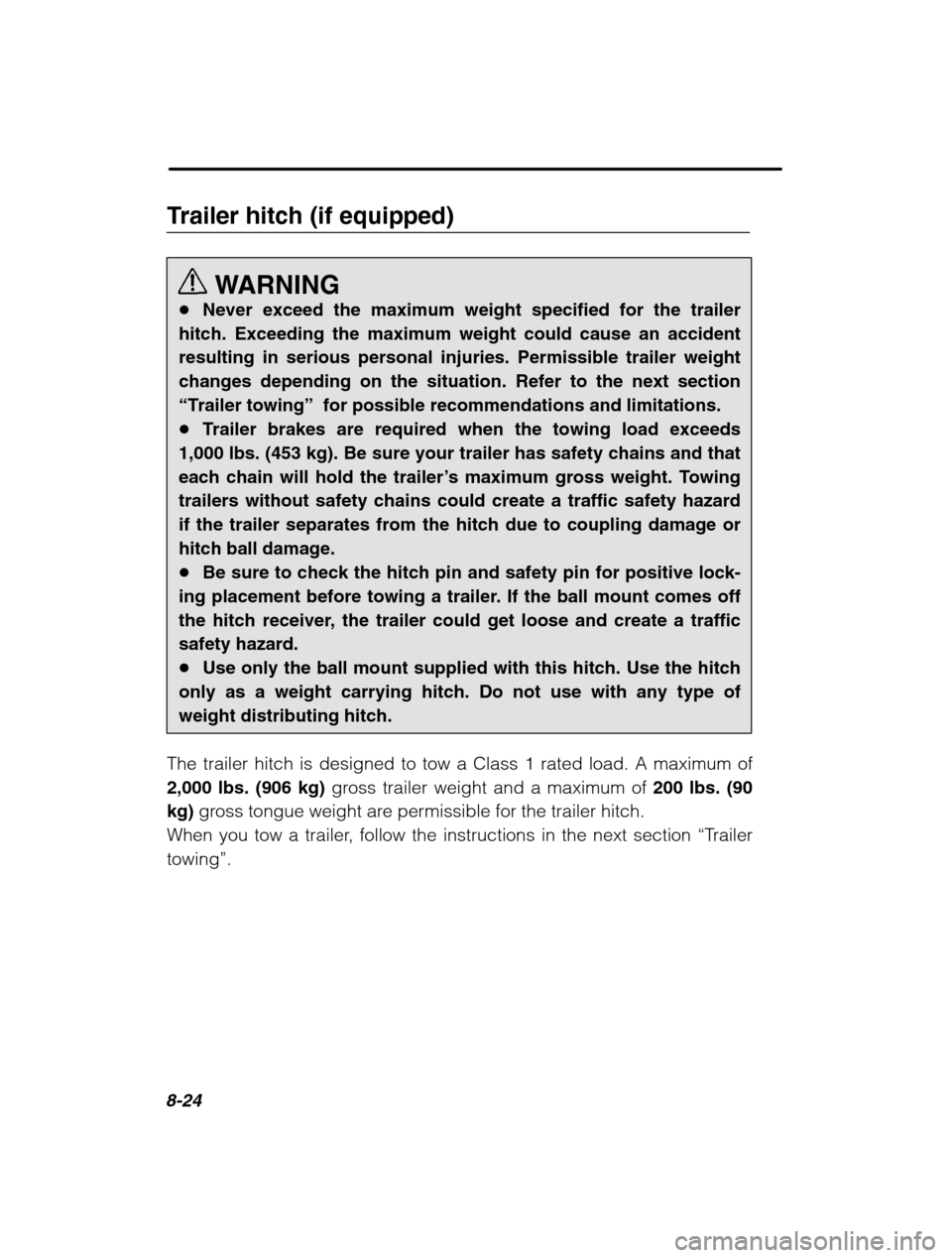
8-24
Trailer hitch (if equipped)WARNING
� Never exceed the maximum weight specified for the trailer
hitch. Exceeding the maximum weight could cause an accident resulting in serious personal injuries. Permissible trailer weight
changes depending on the situation. Refer to the next section“ Trailer towing ” for possible recommendations and limitations.
� Trailer brakes are required when the towing load exceeds
1,000 lbs. (453 kg). Be sure your trailer has safety chains and that
each chain will hold the trailer ’s maximum gross weight. Towing
trailers without safety chains could create a traffic safety hazardif the trailer separates from the hitch due to coupling damage orhitch ball damage.� Be sure to check the hitch pin and safety pin for positive lock-
ing placement before towing a trailer. If the ball mount comes off
the hitch receiver, the trailer could get loose and create a trafficsafety hazard.� Use only the ball mount supplied with this hitch. Use the hitch
only as a weight carrying hitch. Do not use with any type ofweight distributing hitch.
The trailer hitch is designed to tow a Class 1 rated load. A maximum of
2,000 lbs. (906 kg) gross trailer weight and a maximum of 200 lbs. (90
kg) gross tongue weight are permissible for the trailer hitch.
When you tow a trailer, follow the instructions in the next section “Trailer
towing”.
Page 324 of 466
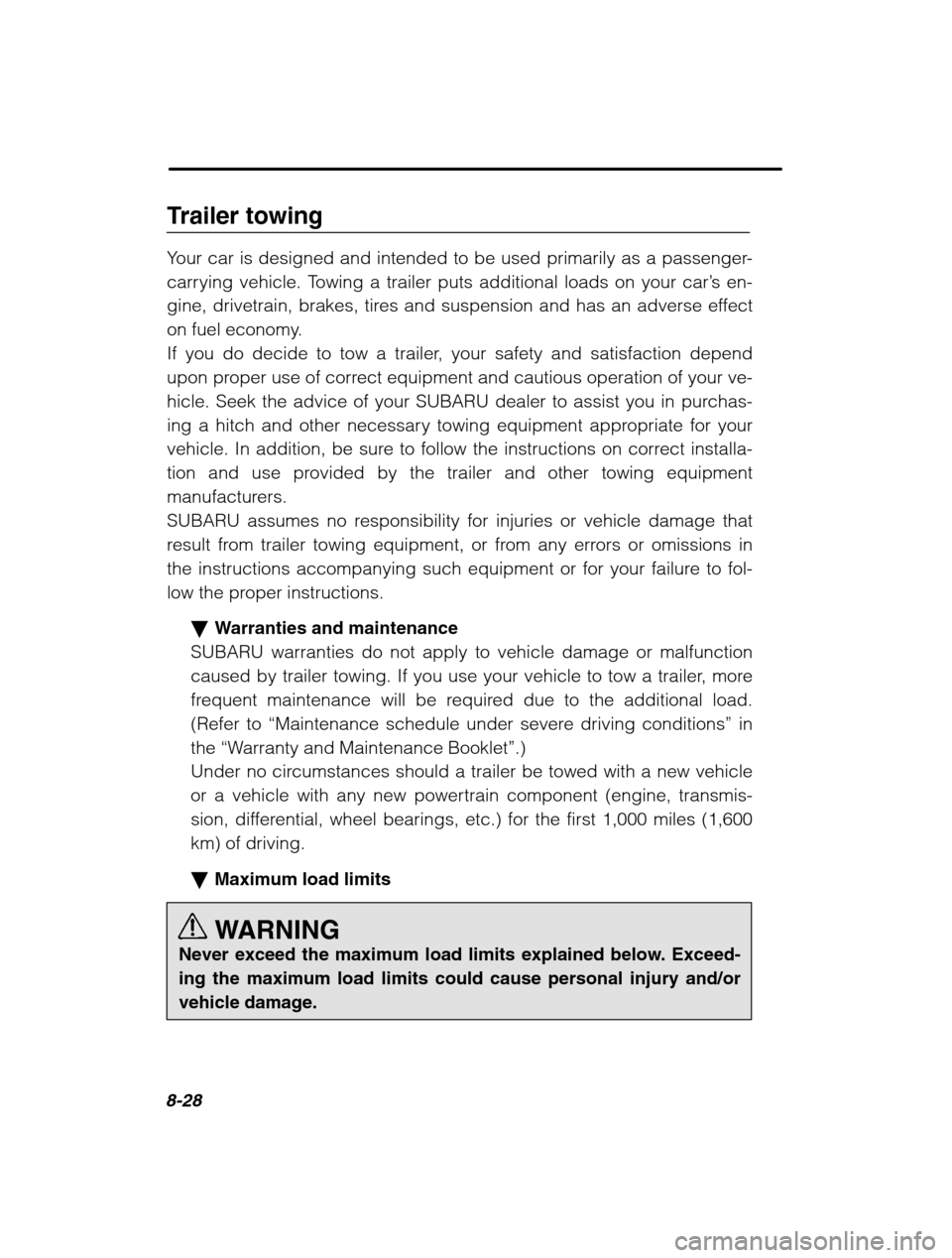
8-28
Trailer towing
Your car is designed and intended to be used primarily as a passenger-
carrying vehicle. Towing a trailer puts additional loads on your car’s en-
gine, drivetrain, brakes, tires and suspension and has an adverse effect
on fuel economy.
If you do decide to tow a trailer, your safety and satisfaction depend
upon proper use of correct equipment and cautious operation of your ve-
hicle. Seek the advice of your SUBARU dealer to assist you in purchas-
ing a hitch and other necessary towing equipment appropriate for your
vehicle. In addition, be sure to follow the instructions on correct installa-
tion and use provided by the trailer and other towing equipment
manufacturers.
SUBARU assumes no responsibility for injuries or vehicle damage that
result from trailer towing equipment, or from any errors or omissions in
the instructions accompanying such equipment or for your failure to fol-
low the proper instructions.
�Warranties and maintenance
SUBARU warranties do not apply to vehicle damage or malfunction
caused by trailer towing. If you use your vehicle to tow a trailer, more
frequent maintenance will be required due to the additional load.(Refer to “Maintenance schedule under severe driving conditions ” in
the “Warranty and Maintenance Booklet ”.)
Under no circumstances should a trailer be towed with a new vehicle
or a vehicle with any new powertrain component (engine, transmis-
sion, differential, wheel bearings, etc.) for the first 1,000 miles (1,600km) of driving. � Maximum load limits
WARNING
Never exceed the maximum load limits explained below. Exceed- ing the maximum load limits could cause personal injury and/or
vehicle damage.
Page 327 of 466

Driving tips8-31
–
CONTINUED –
HBF019BB
Gross Axle Weight
OM-H2784
To check both GVWR and GAWR and to confirm that the total weight
and weight distribution are within safe driving limits, you should have
your vehicle and trailer weighed at a commercial weighing station.
Be sure that all cargo is firmly secured to prevent a change in weight
distribution while driving. nTongue load
WARNING
If the trailer is loaded with more weight in the back of trailer ’s
axle than in the front, the load is taken off the rear axle of the tow- ing vehicle. This may cause the rear wheels to skid, especiallyduring braking or when vehicle speed is reduced during corner-
ing, resulting in over-steer, spin out and/or jackknifing.
Ensure that the trailer tongue load is from 8 to 11 percent of the total
trailer weight and does not exceed the maximum value of 200 lbs (90kg).
The tongue load can be weighed with a bathroom scale as shown in
the illustration below. When weighing the tongue load, be sure to posi-
tion the towing coupler at the height at which it would be during
actual towing, using a jack as shown.